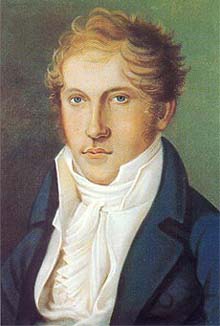Related Research Articles

John Field was an Irish pianist, composer and teacher widely credited as the creator of the nocturne. While other composers were writing in a similar style at this time, Field was the first to use the term 'Nocturne' specifically to apply to a character piece featuring a cantabile melody over an arpeggiated accompaniment.

Louis Spohr, baptized Ludewig Spohr, later often in the modern German form of the name Ludwig was a German composer, violinist and conductor.

Henri François Joseph Vieuxtemps was a Belgian composer and violinist. He occupies an important place in the history of the violin as a prominent exponent of the Franco-Belgian violin school during the mid-19th century. He is also known for playing what is now known as the Vieuxtemps Guarneri del Gesù, a violin of superior workmanship.

Franz Adolf Berwald was a Swedish Romantic composer and violinist. He made his living as an orthopedist and later as the manager of a saw mill and glass factory, and became more appreciated as a composer after his death than he had been in his lifetime.

Giovanni Battista Viotti was an Italian violinist whose virtuosity was famed and whose work as a composer featured a prominent violin and an appealing lyrical tunefulness. He was also a director of French and Italian opera companies in Paris and London. He personally knew Joseph Haydn and Ludwig van Beethoven.

Franz Xaver Wolfgang Mozart, also known as Wolfgang Amadeus Mozart, Jr., was the youngest child of six born to Wolfgang Amadeus Mozart and his wife Constanze and the younger of his parents' two surviving children. He was a composer, pianist, conductor, and teacher of the late classical period whose musical style was of an early Romanticism, heavily influenced by his father's mature style. He knew Franz Schubert and Robert Schumann, both of whom held him in high esteem.

Ferdinand Ries was a German composer. Ries was a friend, pupil and secretary of Ludwig van Beethoven. He composed eight symphonies, a violin concerto, nine piano concertos, three operas, and numerous other works, including 26 string quartets. In 1838 he published a collection of reminiscences of his teacher Beethoven, co-written with Beethoven's friend, Franz Wegeler. Ries' symphonies, some chamber works—most of them with piano—his violin concerto and his piano concertos have been recorded, exhibiting a style which, given his connection to Beethoven, lies between the Classical and early Romantic styles.

Bernhard Molique was a German violinist and composer.

Philip Cipriani Hambly Potter was an English musician. He was a composer, pianist, conductor and teacher. After an early career as a performer and composer, he was a teacher in the Royal Academy of Music in London and was its principal from 1832 to 1859.

Karol Kazimierz Kurpiński was a Polish composer, conductor and pedagogue. He was a representative of late classicism and a member of the Warsaw Society of Friends of Learning. He is also known for having composed the music to the 1831 patriotic song La Varsovienne with lyrics by Casimir Delavigne. He was also a mentor and an influence on young Chopin.
Tommaso Giordani was an Italian composer active in England and particularly in Ireland.

Feliks Janiewicz, in English often Felix Yaniewicz was a Polish composer and violinist in exile.
Philip Cogan was an Irish composer, pianist, and conductor.
John William Glover was an Irish composer, conductor, organist, violinist, and teacher.
Thomas Simpson Cooke was an Irish composer, conductor, singer, theatre musician and music director – an influential figure in early 19th-century opera in London.
Thomas Christopher Kelly was an Irish composer, teacher and conductor.
Peter K. Moran [P. K. Moran] was an Irish pianist, composer, and music publisher – probably the earliest classical composer from Ireland to emigrate to the United States.
References
- ↑ A. Choron, Fr. Fayolle: Dictionnaire historique des musiciens, 2 volumes (Paris 1810 and 1811).
- ↑ Jean Gribenski: "Alday", in Die Musik in Geschichte und Gegenwart, biographical part, volume 1 (Kassel: Bärenreiter, 1999), cc. 410–413.
- ↑ Barra Boydell: "Alday, [Jérôme] Paul [Bonaventure]", in The Encyclopaedia of Music in Ireland, ed. Harry White and Barra Boydell (Dublin: UCD Press, 2013), p. 11.
- ↑ Boydell (2013).
- ↑ This is not the same as the London Anacreontic Society. The Dublin society existed c.1740–1850); see Catherine Ferris: "Anacreontic Society", in The Encyclopaedia of Music in Ireland (2013), see above, p. 21–22.
- ↑ Another private musical society active in Dublin between 1786 and 1824; see Catherine Ferris: "Sons of Handel", ibid., p. 944.
- ↑ Dublin Magazine, March 1820, quoted after Boydell (2013).